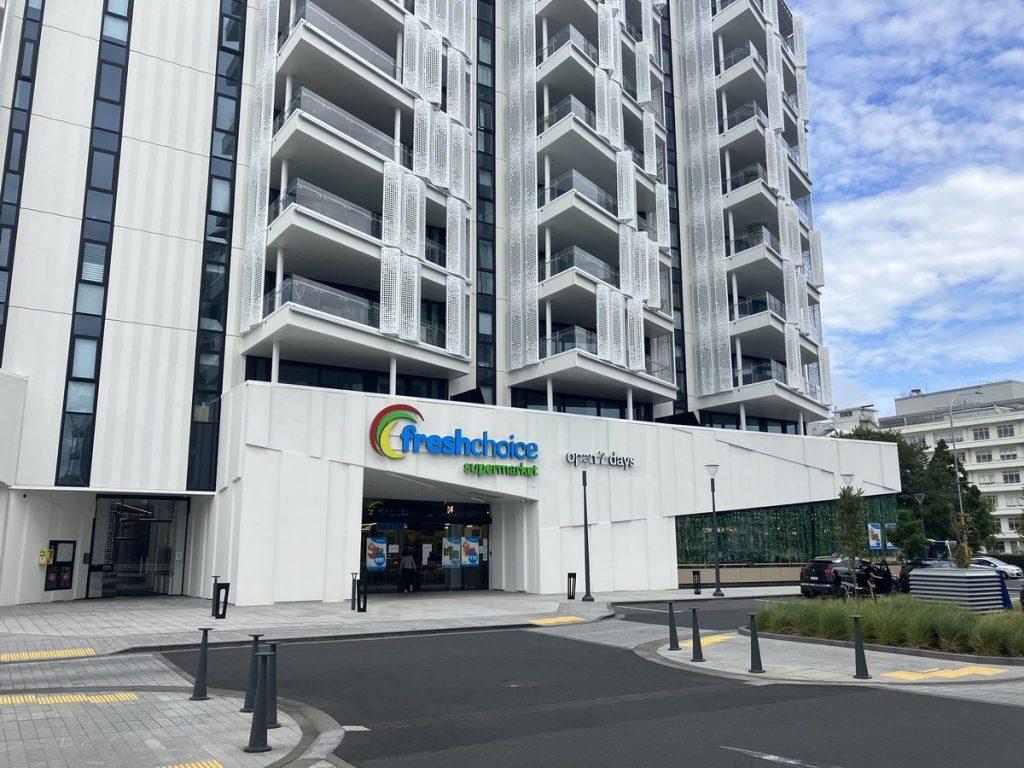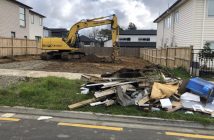Though National’s decision to somewhat back down on the Medium Density Residential Standards (MDRS) comes as a disappointment, there are some good new policies in this plan, Better things are possible author Malcolm McCracken writes

An 8 storey, mixed-use development in Greenlane, Auckland with a small supermarket on the ground floor, shows exactly the sort of development we should be encouraging around our rapid transit stations.
It’s important to start with the primary outcome of a National-led government implementing this plan – the ability for Councils to opt-out of the MDRS. Instead, National plans to introduce ‘Land for Housing Growth Targets’ for Tier One and Two urban areas in New Zealand. This gives Councils the ability to opt out if they provide “30 years’ worth of developable housing capacity” in the short term, elsewhere through higher density in centres and walking catchments, or in greenfield developments.
This doesn’t go far enough. Many councils will not have to do much to meet 30 years of theoretical capacity in their district plan. It does not mean we will actually get the capacity where we need it, which is in the most central locations close to jobs, education and services. National’s plan provides an opportunity for councils to opt out of this if they face challenges from the existing residents. Furthermore, full implementation of the MDRS in district plans, would almost deliver more than 30 years theoretical capacity.
For the development market to function effectively, there is a need for significantly more theoretical capacity, to ensure that enough financially feasible sites can be purchased and developed. As a headline, 30 years can seem to be enough but a majority of the supply will likely not be realised. Therefore, it needs to go further. To meet the 10-to-30-year demand will require significantly more capacity again. I think we should be going much further now and the MDRS, ideally with some improvements, would be a step in the right direction.
Secondly, this policy doesn’t necessarily ensure housing supply where it is required or ensure variety of typologies and sizes of dwelling can realistically be built to meet varied demand. We should be seeking to enable an abundance of housing capacity, which will support higher housing supply and choice, in terms of typology and location.
However, while they are backing down to some extent on the MDRS, which is disappointing, there are some good new policies in this plan.
Mixed-use development around rapid transit
Firstly, National intends to strengthen the NPS-UD requirement for councils to zone for at least six storeys in the walking catchments of rapid transit stations and major town and city centres, to enable mixed-use development.
This would be excellent. Enabling mixed use development, particularly for retail and commercial floors to residential buildings is critical to supporting medium to high density living, with access to daily needs provided through proximity. The only concern I have with this policy is its potential to slow down the “fast track” plan change processes underway to enact the NPS-UD. In the medium term, we should be aiming for small scale retail and commercial to be a permitted activity in all residential neighbourhoods to promote local living.
Removing greenfield subsidies
National also plan to require local councils to ensure that infrastructure for new greenfield development will be funded from rates and levies applied to the new development, instead of being subsidised through rates from other communities. As I have previously covered, given the incredibly high infrastructure costs of greenfield development, the current subsidies for greenfield development make little sense, when it also contributes to higher emissions from our transport system. I think this would be a seriously positive climate perspective, as it could further shift demand towards urban intensification and allow councils to concentrate on the existing urban area.
Strengthening central government powers and financing mechanisms
The second section of their policy focuses on infrastructure financing tools. All of which vary from fine to good. National plan to reform the Infrastructure Funding and Financing (IFF) Act, which enables the use of Special Purpose Vehicles (SPVs) to raise debt and fund infrastructure. I have previously covered the use SPVs in Tauranga which was extremely positive in my view but is a rare example. It is not clear why there has not been greater uptake of this financing mechanism but National is proposing to put it all within the management of Crown Infrastructure Partners, in aim to simplify the process.
National also plans to introduce value capture mechanisms for major projects that unlock housing growth, as major projects tend to increase land values in the surrounding area to the benefit of existing land owners, at cost to the public. This could be really positive for major transport infrastructure projects and based on previous comments from other parties, this could have strong bipartisan support. My primary concern is the wording of the document, which seems to suggest public transport infrastructure is only required for existing urban areas. If we are to have greenfield expansion of our major centres, this needs to include rapid transit.
The third section of Going for Housing Growth focuses on incentives for councils. Build for Growth is a $1 Billion fund that will be distributed based on the number of building consents Councils issue above their 5-year average. This does offer a serious incentive for Councils with $25,000 for every dwelling they consent above average. According to National’s policy document, this means Auckland Council would have been eligible for a payment of $152 million last year, while Tauranga, who did not exceed their 5-year average, would not have been eligible for any payment.
This fund has a lot in common with the Infrastructure Acceleration Fund and in principle, I support the idea of incentives to shift Council’s to be pro-growth. However, I worry this could end up favouring Councils who historically have not consented enough, whereas areas like Auckland, which has much higher consent rates on the back of the Auckland Unitary Plan, may find it harder to surpass the historical average. Especially in a slowing market.
The funding for Build for Growth, seems to be proposed to be redistributed from various existing funds managed by Kāinga Ora. My key concern here is how this will limit the ability of Kāinga Ora developments to keep alive the medium to high rise construction market in a slowing housing market, which is impacting new build sales. It would also take funding which allows Kāinga Ora to buy new land, in towns and neighbourhoods where they don’t have existing land holdings, reducing the ability to provide social housing where it is needed.
National also say they will legislate to give central government reserve powers to rezone land where required to achieve Housing Growth Targets. This generally seems positive given the historical failings of local government and political blockade that can occur, like in Christchurch in 2022, where the Council refused to adopt the MDRS.
Other changes
There are a number of other changes, here is a high level summary:
- A “Refocused National Policy Statement on Highly Productive Land”. National plans to update the NPS-HPL to keep protection of the most productive soils (LUC 1 & 2), while allowing for LUC-3 category land to be opened up for development.
- Requiring future zoned greenfield land to be live zoned now. It is unclear how this is intended to balance the need for commercial and industrial land in greenfield areas. It could also create conflict with the (excellent) requirement for greenfield infrastructure to be self-funded. The details are unclear on this from what is a high-level policy document.
- Encouraging additional density in transport corridors would be great but the 30-year requirement is unlikely to be enough to push councils into any major changes.
Conclusion
In summary, providing the opt-out from the MDRS is likely to lead to a reduction in housing capacity and housing choice. I don’t think providing the choice councils will necessarily lead to more or better housing supply. However, there are some strong policies on mixed-use development, reducing public subsidy of greenfield development, and infrastructure financing, that would be positive if implemented. The best outcome for housing and climate would be an improved MDRS, alongside these more positive proposed policies from the National Party.
Malcolm McCracken is a Transport Planner with Sustainable Transport Consultancy, MRCagney. Malcolm has diverse experience in transport planning & strategy, policy development, and transport and land-use integration. He is also currently undertaking a Masters in Public Policy at the Auckland University.



